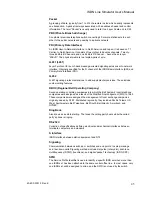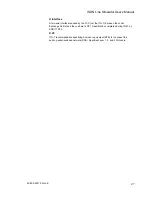
ISDN Line Simulator User’s Manual
40-400-00012, Rev. E
46
SS7 (Signaling System Number 7)
An international, standard, common channel signaling system. SS7 is used between
public network switches (replacing per-trunk signaling), local exchange carrier
switches, interexchange carrier switches, and (increasingly) between local and
interexchange carrier networks.
Switch
Generic term for machines that switch telephone calls from/to telephones and/or
trunks. Includes private branch exchanges (PBX) as well as other premises based
systems, and public network central office machines such as local exchange
switches, tandem switches, toll switches, interexchange carrier switches, and
gateway switches.
Synchronous Transmission
Data communication protocol set where data is sent continuously. The receiver and
transmitter are in constant bit synchronization. Character (byte) synchronization is
achieved by a Layer 2 Flag character transmitted at the start of each block.
Synchronous transmission is normally found on the faster circuits, e.g. rates of 4.8
Kb/s and above.
T Interface
ISDN Interface between station equipment and NT1. For the Basic Interface this is a
4 wire connection limited to 1 KM.
TA (ISDN) (Terminal Adapter)
ISDN Customer-owned protocol converter. Converts from a standard non-ISDN
interface (e.g. X.25, RS-232) to ISDN S/T interface.
TE (Terminal Equipment)
ISDN equipment category including TE1s, TAs and TE2s.
TE1 (Terminal Equipment type 1)
Terminal Equipment meeting ISDN interface specifications such as ISDN phones,
ISDN terminals, etc.
TE2 (Terminal Equipment type 2)
Terminal Equipment providing interfaces other than ISDN, for example, non-ISDN
equipment. Needs an appropriate terminal adapter (TA) to connect to ISDN.
TEI (Terminal Endpoint Identifier)
An ISDN device’s Layer 2 address that is unique on a passive bus. Used to establish
independent data inks between the switch and each device on a passive bus.
Tip/Ring
The negative (tip, or ground) and positive (ring, or battery) wires of an analog lines.
Refers to an analog line, rather than a digital line.
Twisted pair
Twisted pair insulated copper wire is used extensively in the telco network to support
analog-grade communications, such as the type of wiring generally supplied to serve
a local loop for a home. Twisted pair is normally .035-.016 inches (22-26 AWG). This
type of facility is used by the telco to supply ISDN BRI to an individual or centrex
subscriber.
Содержание ILS-C
Страница 1: ...ISDN Line Simulator ILS C User s Manual 40 400 00012 Rev E ...
Страница 8: ......


































